A Study on the Perception of Local Characteristics in Cultural Street Vending Spaces, Taking Xi’an Baxian Temple as an Example
Abstract
1. Introduction
2. Literature Review
2.1. Identification of Historic District Elements
2.2. Environmental Perception
2.3. Conservation and Renewal of Historic Districts
3. Materials and Methods
3.1. Materials
3.2. Methods
3.2.1. Selection of Adjective Pairs
3.2.2. Selection of Participants
3.2.3. Experimental Procedure
3.3. Analytic Techniques
4. Results
4.1. Semantic Perception Analysis
4.1.1. Market Day and Non-Market Day Semantic Evaluation
4.1.2. Factor Analysis
4.2. Characteristic Element Identification
4.2.1. Non-Specific Elements
4.2.2. Specific Elements
4.2.3. Relationship between Vendors and Elements Perception
- People’s perceptual focus was more clustered both horizontally and vertically over the physical range.
- For elements at close distances, the number of perceived elements increased and the figurative ability increased.
- The perception of colour was more sensitive for larger areas at a distance.
4.3. Correlation Analysis of Semantic and Elemental Perception
4.3.1. Relationship between Street Elements and Fa①–⑥【W】
4.3.2. Relationship of Street Elements to Fa①–⑥【N】 and Fa①–⑧【M】
5. Discussion
- The SD method, with 33 pairs of adjectives, has a large semantic dimension and is slightly more difficult to understand, so 30 architecture students were chosen as evaluators. In the future, based on the representative adjective pairs extracted from the factor analysis, experiments can be conducted with people from different social backgrounds on the basis of reducing the number of semantic meanings to increase the size and diversity of the sample.
- There is a need for more street objects of this type to explore how perceptual patterns and cognitive maps differ across Cultural Street Vending spaces.
- The conservation renewal strategy that was proposed based on the results of the analysis of psychological perception and elemental perception lacks empirical research. In the future, a secondary evaluation can be conducted by simulating the effect of improved streets [49] to verify the actual effect of the improved strategies on psychological perception.
- In this paper, the negative effects of Cultural Street Vending, such as noise, have not been further investigated. In the future, questionnaire surveys of nearby residents can be used to verify whether the negative problem exists and how serious it is.
- This paper makes an attempt at the combination of the SD method and element recall method in terms of methodology for the temporal variation attributes of streets in Street Urbanism. However, at the theoretical level, a complete explanatory model between cognitive elements and built environment elements has not yet been established, which needs to be improved by more street samples in the future. At the same time, exploring the temporal variation attributes of streets in the future can not only be based on semantic cognition and memory image cognition but also include other data acquisition means advocated in the DAD (data augmented design) [29]. This will also be one of the attempts of this paper in the future.
6. Conclusions
- The SD method revealed that street vending brought more positive feelings. Six factors were extracted in 【W】 through factor analysis, and the overall characteristics of the Baxian Temple Cultural Street Vending space were “expectant” and “vital”, which were mainly caused by the activities of the vendors. Six factors were extracted in 【N】, and the main characteristics were “distant” and “ubiquitous”. In 【M】, eight factors were proposed, and the characteristics of “novel” and “vital” were highlighted. It can be said that the activities of the vendors on the market day significantly elicited positive evaluations, reflecting the local characteristics of the street space in Baxian Temple. On the other hand, the representative adjective pairs of each factor could be used for the spatial evaluation of the historic streets of Baxian Temple for the whole space or in different states. Among them, the impression factor, vitality factor, and morphosis factor were found to be the three commonality factors in 【N·M·W】.
- Specific and non-specific elements were identified through the element recall method. A comparison of the specific and non-specific elements identified the local element components with high, medium, and low local characteristics. The contrast between 【N】 and 【M】 revealed that human perception was smaller in scope, larger in volume and more figurative on market day.
- A correlation analysis between psychological perception and elemental perception uncovered the relationship between the psychological quantities and the physical environments of the streets. People’s positive psychology has a positive correlation with the perceived number of elements of vendors, goods, street components and the way vendors are distributed, while a negative correlation with the perceived number of elements of greenery, colour and texture.
Author Contributions
Funding
Data Availability Statement
Conflicts of Interest
Appendix A
| Street Number | Element Name | Pointing Out Rate | Pointing Out Rate Range | Number of Elements | Total Elements |
|---|---|---|---|---|---|
| 【1N】 | Cars | 83.33% | 75–100% | 1 | 8 |
| Wall | 70.00% | 50–75% | 4 | ||
| Telegraph poles | 66.67% | ||||
| Funeral supplies shop | 56.67% | ||||
| Signboards | 50.00% | ||||
| Trees | 33.33% | 25–50% | 3 | ||
| Pedestrians | 30.00% | ||||
| Street lamps | 26.67% | ||||
| 【1M】 | Street vending | 83.33% | 75–100% | 2 | 8 |
| Cars | 80.00% | ||||
| Wall | 66.67% | 50–75% | 3 | ||
| Pedestrians | 56.67% | ||||
| Telegraph poles | 50.00% | ||||
| Goods from vendors | 46.67% | 25–50% | 3 | ||
| Signboards | 36.67% | ||||
| Funeral supplies shop | 33.33% |
| Street Number | Element Name | Pointing Out Rate | Pointing Out Rate Range | Number of Elements | Total Elements |
|---|---|---|---|---|---|
| 【2N】 | Cars | 86.67% | 75–100% | 2 | 8 |
| Stalls from shop | 80.00% | ||||
| Buildings | 56.67% | 50–75% | 1 | ||
| Antique shops | 40.00% | 25–50% | 5 | ||
| Antiques | 36.67% | ||||
| Signboards | 36.67% | ||||
| Red | 33.33% | ||||
| Parking lot | 33.33% | ||||
| 【2M】 | Street vending | 80.00% | 75–100% | 1 | 10 |
| Goods from vendors | 70.00% | 50–75% | 3 | ||
| Cars | 66.67% | ||||
| Pedestrians | 60.00% | ||||
| Buildings | 43.33% | 25–50% | 6 | ||
| Antique shops | 40.00% | ||||
| Red | 33.33% | ||||
| Glass | 26.67% | ||||
| Signboards | 26.67% | ||||
| Stalls from shop | 26.67% |
| Street Number | Element Name | Pointing Out Rate | Pointing Out Rate Range | Number of Elements | Total Elements |
|---|---|---|---|---|---|
| 【3N】 | Shops | 83.33% | 75–100% | 1 | 7 |
| Signboards | 60.00% | 50–75% | 3 | ||
| Stalls from shop | 53.33% | ||||
| Buildings | 50.00% | ||||
| Cars | 46.67% | 25–50% | 3 | ||
| Pedestrians | 33.30% | ||||
| Wires | 30.00% | ||||
| 【3M】 | Street vending | 73.33% | 50–75% | 4 | 8 |
| Goods | 70.00% | ||||
| Pedestrians | 63.33% | ||||
| Cars | 60.00% | ||||
| Shops | 43.33% | 25–50% | 4 | ||
| Signboards | 40.00% | ||||
| Buildings | 33.33% | ||||
| Wires | 26.67% |
| Street Number | Element Name | Pointing Out Rate | Pointing Out Rate Range | Number of Elements | Total Elements |
|---|---|---|---|---|---|
| 【4N】 | Wall | 93.33% | 75–100% | 3 | 7 |
| Trees | 80.00% | ||||
| Street vending | 76.67% | ||||
| Cars | 66.67% | 50–75% | 2 | ||
| White | 50.00% | ||||
| Pedestrians | 43.33% | 25–50% | 2 | ||
| Iron fence | 33.33% | ||||
| 【4M】 | Street vending | 86.67% | 75–100% | 4 | 12 |
| Wall | 86.67% | ||||
| Trees | 80.00% | ||||
| Cars | 76.67% | ||||
| Pedestrians | 56.67% | 50–75% | 2 | ||
| White | 53.33% | ||||
| Stool | 36.67% | 25–50% | 4 | ||
| Road | 33.33% | ||||
| Iron fence | 30.00% | ||||
| Ancient building stone carving | 26.67% |
| Street Number | Element Name | Pointing Out Rate | Pointing Out Rate Range | Number of Elements | Total Elements |
|---|---|---|---|---|---|
| 【5N】 | Cars | 93.33% | 75–100% | 3 | 11 |
| Wall | 86.67% | ||||
| Trees | 83.33% | ||||
| Street lamps | 46.67% | 25–50% | 8 | ||
| White | 40.00% | ||||
| Sidewalk | 36.67% | ||||
| Garbage cans | 33.33% | ||||
| Sky | 33.33% | ||||
| Road signs | 30.00% | ||||
| Distant buildings | 30.00% | ||||
| Road | 30.00% | ||||
| 【5M】 | Street vending | 90.00% | 75–100% | 3 | 12 |
| Cars | 80.00% | ||||
| Trees | 76.67% | ||||
| Wall | 73.33% | 50–75% | 2 | ||
| Pedestrians | 73.33% | ||||
| Goods from vendors | 40.00% | 25–50% | 7 | ||
| Street lamps | 36.67% | ||||
| White | 36.67% | ||||
| Sidewalk | 33.33% | ||||
| Road | 26.67% | ||||
| Garbage cans | 26.67% | ||||
| Sky | 26.67% |
| Street Number | Element Name | Pointing Out Rate | Pointing Out Rate Range | Number of Elements | Total Elements |
|---|---|---|---|---|---|
| 【6N】 | Trees | 86.67% | 75–100% | 2 | 8 |
| Cars | 80.00% | ||||
| Shops | 66.67% | 50–75% | 3 | ||
| Pedestrians | 66.67% | ||||
| Buildings | 63.33% | ||||
| Signboards | 40.00% | 25–50% | 3 | ||
| Telegraph poles | 33.33% | ||||
| Sidewalk | 26.67% | ||||
| 【6M】 | Cars | 93.33% | 75–100% | 3 | 8 |
| Street vending | 86.67% | ||||
| Trees | 76.67% | ||||
| Shops | 66.67% | 50–75% | 2 | ||
| Buildings | 53.33% | ||||
| Goods from vendors | 43.33% | 25–50% | 3 | ||
| Signboards | 43.33% | ||||
| Pedestrians | 33.33% |
| Street Number | Element Name | Pointing Out Rate | Pointing Out Rate Range | Number of Elements | Total Elements |
|---|---|---|---|---|---|
| 【7N】 | Trees | 86.67% | 75–100% | 3 | 11 |
| Wall | 76.67% | ||||
| Cars | 76.67% | ||||
| Telegraph poles | 73.33% | 50–75% | 3 | ||
| Shops | 66.67% | ||||
| Buildings | 53.33% | ||||
| Signboards | 36.67% | 25–50% | 5 | ||
| Garbage cans | 33.33% | ||||
| Street lamps | 33.33% | ||||
| White | 26.67% | ||||
| Pedestrians | 26.67% | ||||
| 【7M】 | Street vending | 86.67% | 75–100% | 2 | 12 |
| Trees | 76.67% | ||||
| Cars | 73.33% | 50–75% | 4 | ||
| Pedestrians | 70.00% | ||||
| Wall | 60.00% | ||||
| Telegraph poles | 60.00% | ||||
| Shops | 46.67% | 25–50% | 6 | ||
| Goods from vendors | 46.67% | ||||
| Buildings | 43.33% | ||||
| Road | 30.00% | ||||
| Signboards | 30.00% | ||||
| Garbage cans | 26.67% |
Appendix B
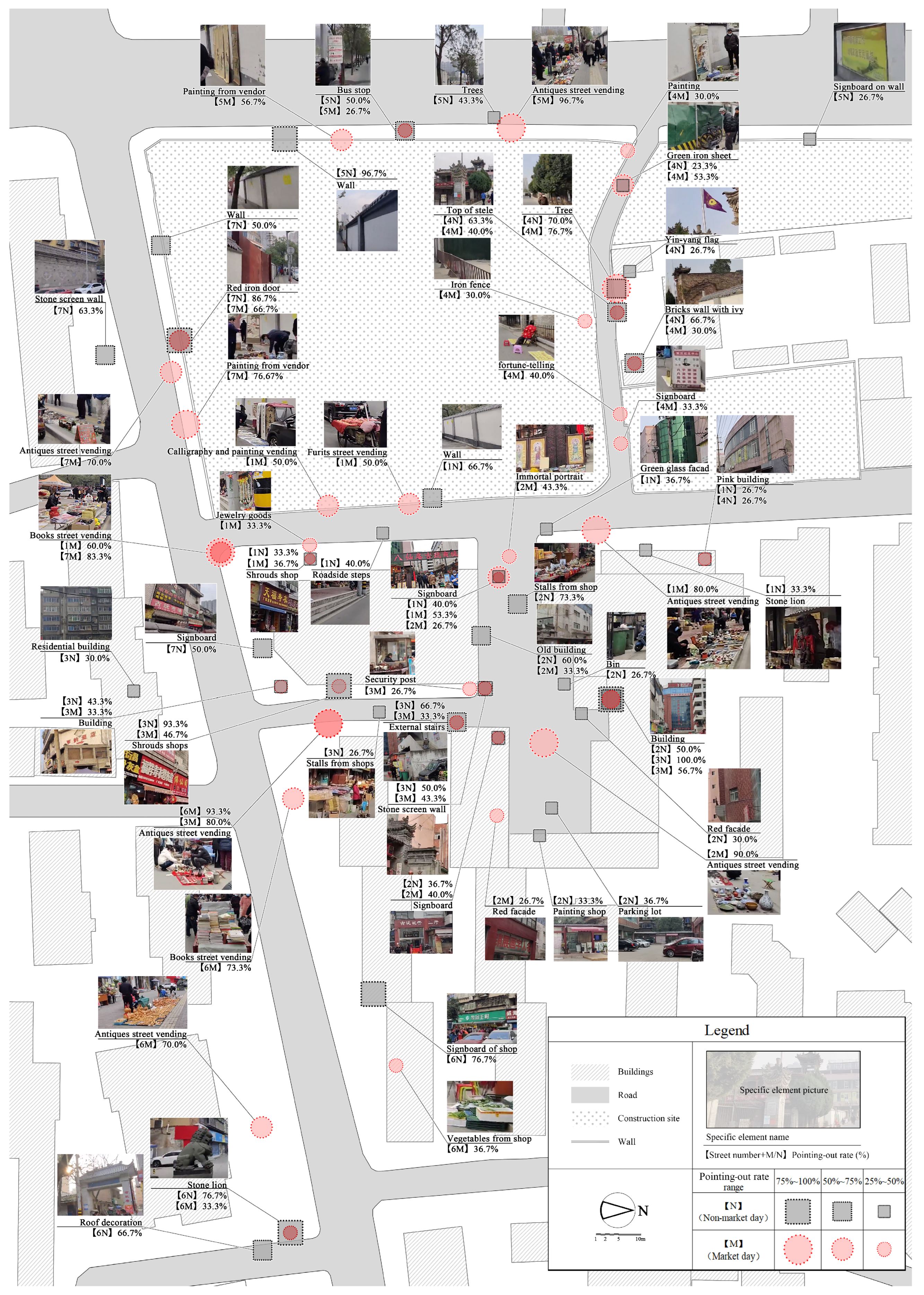
References
- Zheng, B.; Masrabaye, F.; Guiradoumngué, G.M.; Zheng, J.; Liu, L. Progress in Research on Sustainable Urban Renewal Since 2000: Library and Visual Analyses. Sustainability 2021, 13, 4154. [Google Scholar] [CrossRef]
- Lin, J.; Ye, Z.; Yang, H. Thoughts on the Underused Urban Land Redevelopment in the Era of Inventory Planning. China Land Sci. 2019, 33, 1–8. (In Chinese) [Google Scholar] [CrossRef]
- Zhu, M.; Chen, J.; Guo, M.; Yue, W. Perception-Signal-Emotion: Experimental Research and Exploration of Human scale Spatial Perception Based on Physiological Signals. Urban Plan. Int. 2023, 38, 19–28. (In Chinese) [Google Scholar] [CrossRef]
- Biddulph, M. Sustainable Urban design: An environmental approach, 2nd Edition. URBAN DESIGN Int. 2010, 15, 68–70. [Google Scholar] [CrossRef]
- Long, Y.; Ye, Y. Human-Scale Urban Form: Measurements, Performances, and Urban Planning & Design Interventions. South Archit. 2016, 175, 41–47. (In Chinese) [Google Scholar] [CrossRef]
- Hawas, M.A.; Hawas, M.A. Heritage Planning: Adaptation of the “Old & New Approach” Towards Estblishing Conservation Areas in Metropolitan Cities. Procedia-Soc. Behav. Sci. 2016, 225, 348–363. [Google Scholar] [CrossRef]
- Yung, E.H.K.; Zhang, Q.; Chan, E.H.W. Underlying social factors for evaluating heritage conservation in urban renewal districts. Habitat Int. 2017, 66, 135–148. [Google Scholar] [CrossRef]
- Shan, J. Protection of Historical and Cultural Blocks; Tianjin University Press: Tianjin, China, 2015. (In Chinese) [Google Scholar]
- Xi’an Local Records Compilation Committee. Xi’an Chronicle; Xi’an Publishing House: Xi’an, China, 2000. (In Chinese)
- Yang, L.; Zhang, K. Study on the Evolution of Urban Form in Beijing Old City Based on Spatial Syntax. Urban. Archit. 2023, 20, 97–101. (In Chinese) [Google Scholar] [CrossRef]
- Huang, L.; Zheng, W.; Hong, J.; Liu, Y.; Liu, G. Paths and strategies for sustainable urban renewal at the neighbourhood level: A framework for decision-making. Sustain. Cities Soc. 2020, 55, 102074. [Google Scholar] [CrossRef]
- Xu, X.; Xue, D.; Huang, G. The Effects of Residents’ Sense of Place on Their Willingness to Support Urban Renewal: A Case Study of Century-Old East Street Renewal Project in Shaoguan, China. Sustainability 2022, 14, 1385. [Google Scholar] [CrossRef]
- Yoshimura, Y.; He, S.; Hack, G.; Nagakura, T.; Ratti, C. Quantifying Memories: Mapping Urban Perception. Mob. Netw. Appl. 2020, 25, 1275–1286. [Google Scholar] [CrossRef]
- Lynch, K. The Image of the City; MIT Press: Cambridge, UK, 1962. [Google Scholar]
- Gehl, J. Life Between Buildings: Using Public Space; Island Press: Renmark, Australia, 2011. [Google Scholar]
- Marshall, S. Streets and Patterns; Routledge: London, UK, 2004. [Google Scholar]
- Long, Y.; Zhou, Y. Quantitative evaluation on street vibrancy and its impact factors: A case study of Chengdu. New Archit. 2016, 1, 52–57. (In Chinese) [Google Scholar] [CrossRef]
- Xu, l.; Meng, R.; Huang, S.; Chen, Z. Healing Oriented Street Design: Experimental Explorations via Virtual Reality. Urban Plan. Int. 2019, 1, 38–45. (In Chinese) [Google Scholar] [CrossRef]
- He, H.; Fang, Y.; Zhang, T.; Zhang, Q.; Li, M.; Su, C. The Present and Future of Street Space Quality Research: Quantitative Analysis Based on the Visualization Literature at Home and Abroad in the Past Ten Years. Shanghai Urban Plan. Rev. 2022, 6, 73–81. (In Chinese) [Google Scholar] [CrossRef]
- Kiang, H.C. Visualizing Everyday Life in the City. J. Soc. Archit. Hist. 2014, 73, 91–117. [Google Scholar] [CrossRef]
- Li, X.; Yang, X. Planning Of “Ciyun Ancient Street”—A Practical Exploration Based OnTypo-Morphological Approach. Urban Dev. Stud. 2019, 26, 12–16+21. (In Chinese) [Google Scholar]
- Masullo, M.; Castanò, F.; Toma, R.A.; Maffei, L. Historical Cloisters and Courtyards as Quiet Areas. Sustainability 2020, 12, 2887. [Google Scholar] [CrossRef]
- Masullo, M.; Ozcevik Bilen, A.; Toma, R.A.; Akin Guler, G.; Maffei, L. The Restorativeness of Outdoor Historical Sites in Urban Areas: Physical and Perceptual Correlations. Sustainability 2021, 13, 5603. [Google Scholar] [CrossRef]
- Li, X.; Zhang, X.; Jia, T. Humanization of nature: Testing the influences of urban park characteristics and psychological factors on collegers’ perceived restoration. Urban For. Urban Green. 2023, 79, 127806. [Google Scholar] [CrossRef]
- Tafahomi, R. Application of physical and nonphysical elements in the conservation of historic core of city. S. Afr. J. Geomat. 2022, 10, 75–86. [Google Scholar] [CrossRef]
- Hu, Y. A Novel Planning of Vest-Pocket Park in Historic Urban Area in Metropolis: A Case Study of Beijing. In Green Intelligent Transportation Systems; Lecture Notes in Electrical Engineering; Springer: Singapore, 2018; pp. 1035–1053. [Google Scholar]
- Jiang, H.; Lu, S.; Xiao, Y. Method of Urban Color Evaluation for Historic and Cultural Areas in Shanghai Based on Street View Technology. Urban Plan. Forum 2022, 111–118. (In Chinese) [Google Scholar] [CrossRef]
- Tsumita, H.; Hamamoto, S. Analysis on Spacial Structure by Composition of Indication Elements in the City Spaces. J. Archit. Plan. (Trans. AIJ) 2008, 73, 109–116. (In Japanese) [Google Scholar] [CrossRef]
- Long, Y. Street Urbanism A New Perspective for Urban Studies and City Planning in the New Data Environment. Time Archit. 2016, 2, 128–132. (In Chinese) [Google Scholar] [CrossRef]
- Tsumita, H.; Miwata, M. A Study on Psychological Evaluation of Street Space and Composition of Indication Elements on Gulangyu Island and Xiamen Island in Xiamen City. J. Archit. Plan. (Trans. AIJ) 2021, 86, 771–781. (In Japanese) [Google Scholar] [CrossRef]
- Huang, G.; Xue, D.; Jin, L. Micro-location decision making of urban street vendors: Evidence from interviews with 200 vendors in guangzhou. Hum. Geogr. 2016, 1, 57–64. (In Chinese) [Google Scholar] [CrossRef]
- Sheng, Q.; Yang, Z. The Influence of Topological Spatial Form on Commercial Transaction Behaviour in Xinmin Market. World Archit. 2022, 06, 91–95. (In Chinese) [Google Scholar] [CrossRef]
- Deghati Najd, M.; Ismail, N.A.; Maulan, S.; Mohd Yunos, M.Y.; Dabbagh Niya, M. Visual preference dimensions of historic urban areas: The determinants for urban heritage conservation. Habitat Int. 2015, 49, 115–125. [Google Scholar] [CrossRef]
- Tang, J.; Long, Y. Measuring visual quality of street space and its temporal variation: Methodology and its application in the Hutong area in Beijing. Landsc. Urban Plan. 2019, 191, 103436. [Google Scholar] [CrossRef]
- Kiruthiga, K.; Thirumaran, K. Visual perception on the architectural elements of the built heritage of a historic temple town: A case study of Kumbakonam, India. Front. Archit. Res. 2017, 6, 96–107. [Google Scholar] [CrossRef]
- McMullen, M. Seeing history: A visual assessment of the historic-grounding of Old Western tourist towns. J. Herit. Tour. 2017, 13, 411–425. [Google Scholar] [CrossRef]
- Nagaoka, A.; Ogawa, R.; Tsuchiya, T. Affective Engineering for Streetscape Analysis: Evaluation of Traditional Japanese Mud Walls Using a Self-Organizing Map. In Proceedings of the 2013 IEEE International Conference on Systems, Man, and Cybernetics, Manchester, UK, 13–16 October 2013; pp. 1132–1137. [Google Scholar]
- Wang, F.; Hu, W.; Zhu, Y.; Jiang, C. The locality of Beijing historic areas from a dynamic perspective based on geo-tagged photos. Int. J. Tour. Cities 2019, 5, 75–89. [Google Scholar] [CrossRef]
- Kuo, C.-L.; Chan, T.-C.; Fan, I.C.; Zipf, A. Efficient Method for POI/ROI Discovery Using Flickr Geotagged Photos. ISPRS Int. J. Geo-Inf. 2018, 7, 121. [Google Scholar] [CrossRef]
- Gould, P.R.; White, R. Mental Maps; Penguin: London, UK, 1974. [Google Scholar]
- Canter, D. The Psychology of Place; St. Martin’s Press: New York, NY, USA, 1977. [Google Scholar]
- Architectural Institute of Japan. Survey and Analysis Methods for Architecture and Urban Planning; Inoueshoin: Tokyo, Japan, 2012. (In Japanese) [Google Scholar]
- Li, Z.; Sun, X.; Zhao, S.; Zuo, H. Integrating eye-movement analysis and the semantic differential method to analyze the visual effect of a traditional commercial block in Hefei, China. Front. Archit. Res. 2021, 10, 317–331. [Google Scholar] [CrossRef]
- Ming, D.U.; Zheng, C.; Yiyan, C. Designing Attention—Research on Landscape Experience Through Eye Tracking in Nanjing Road Pedestrian Mall (Street) in Shanghai. Landsc. Archit. Front. 2022, 10, 52. [Google Scholar] [CrossRef]
- Osgood, C.E. Commentary on “the Semantic Differential and Mediation Theory”. Linguistics 1971, 9, 88–96. [Google Scholar] [CrossRef]
- Xu, L.; Yong, C. Resident Satisfaction Research on the Conservation Renewal of Traditional Li-long Case Studies of Shanghai Chunyangli and Chengxingli. Archit. J. 2021, 137–143. Available online: http://lab408.org/upload/thesis/1658118225.pdf (accessed on 10 November 2023). (In Chinese).
- Wang, Z.; Zhuang, W. Research on Block Renewal Post Occupancy Evaluation Methods Based on Image Deep Learning: A Case Study of Shichahai in Beijing. New Archit. 2022, 5–8. (In Chinese) [Google Scholar] [CrossRef]
- Wan, J.; Zhou, Y.; Li, Y.; Su, Y.; Cao, Y.; Zhang, L.; Ying, L.; Deng, W. Research on Color Space Perceptions and Restorative Effects of Blue Space Based on Color Psychology: Examination of the Yijie District of Dujiangyan City as an Example. Int. J. Environ. Res. Public Health 2020, 17, 3137. [Google Scholar] [CrossRef]
- Wang, X.; Nishina, D.; Jiang, R.; Liu, N.; Kindaichi, S.; Mizuta, S. The Influence of Townscape-Improvement on the Psychological Evaluation in Saijo Sakagura Area. J. Environ. Eng. (Trans. AIJ) 2021, 86, 215–225. (In Japanese) [Google Scholar] [CrossRef]
- Duan, J.; Lan, W.; Jiang, Y. An evaluation approach to spatial identity in historic urban areas from a humanistic perspective. Front. Archit. Res. 2022, 11, 806–814. [Google Scholar] [CrossRef]
- Jayantha, W.; Yung, E. Effect of Revitalisation of Historic Buildings on Retail Shop Values in Urban Renewal: An Empirical Analysis. Sustainability 2018, 10, 1418. [Google Scholar] [CrossRef]
- Khalaf, R.W. The search for the meaning of ‘compatibility’ between new construction and heritage in historic areas: An exploratory study. Hist. Environ. Policy Pract. 2016, 7, 60–80. [Google Scholar] [CrossRef]
- Liu, Z.; Wang, S.; Wang, F. Isolated or integrated? Planning and management of urban renewal for historic areas in Old Beijing city, based on the association network system. Habitat Int. 2019, 93, 102049. [Google Scholar] [CrossRef]
- Bornioli, A.; Parkhurst, G.; Morgan, P.L. Psychological Wellbeing Benefits of Simulated Exposure to Five Urban Settings: An Experimental Study From the Pedestrian’s Perspective. J. Transp. Health 2018, 9, 105–116. [Google Scholar] [CrossRef]
- Gil, E.; Ahn, Y.; Kwon, Y. Tourist Attraction and Points of Interest (POIs) Using Search Engine Data: Case of Seoul. Sustainability 2020, 12, 7060. [Google Scholar] [CrossRef]
- Deng, Z.; Chen, D.; Qin, X.; Wang, S. Comprehensive assessment to residents’ perceptions to historic urban center in megacity: A case study of Yuexiu District, Guangzhou, China. J. Asian Archit. Build. Eng. 2021, 20, 566–580. [Google Scholar] [CrossRef]
- Hong, Y.; Chen, F. Evaluating the adaptive reuse potential of buildings in conservation areas. Facilities 2017, 35, 202–219. [Google Scholar] [CrossRef]
- Hegazi, Y.S.; Fouda, M. Re-imaging Rosetta historic core through Space Syntax. Archnet-IJAR Int. J. Archit. Res. 2019, 13, 645–669. [Google Scholar] [CrossRef]
- López Sánchez, M.; Linares Gómez Del Pulgar, M.; Tejedor Cabrera, A. Historic construction of diffuse cultural landscapes: Towards a GIS-based method for mapping the interlinkages of heritage. Landsc. Res. 2021, 46, 916–931. [Google Scholar] [CrossRef]
- Li, Y.; Huang, J.; Liang, J.; Zhang, Y.; Chen, Y. Research on Visual Attraction and Influencing Factors of Perception of Commercial Street Space in Cultural Heritage Site: Taking Gulangyu Longtou Road as an Example. J. Hum. Settl. West China 2022, 37, 114–121. (In Chinese) [Google Scholar] [CrossRef]
- Liu, Y.; Liu, Y. Detecting the city-scale spatial pattern of the urban informal sector by using the street view images: A street vendor massive investigation case. Cities 2022, 131, 103959. [Google Scholar] [CrossRef]
- Tan, J.; Chang, J.; Xie, D. Micro Renovation Of Yongqing Block, Enning Road, Guangzhou. Planners 2018, 34, 62–67. (In Chinese) [Google Scholar]

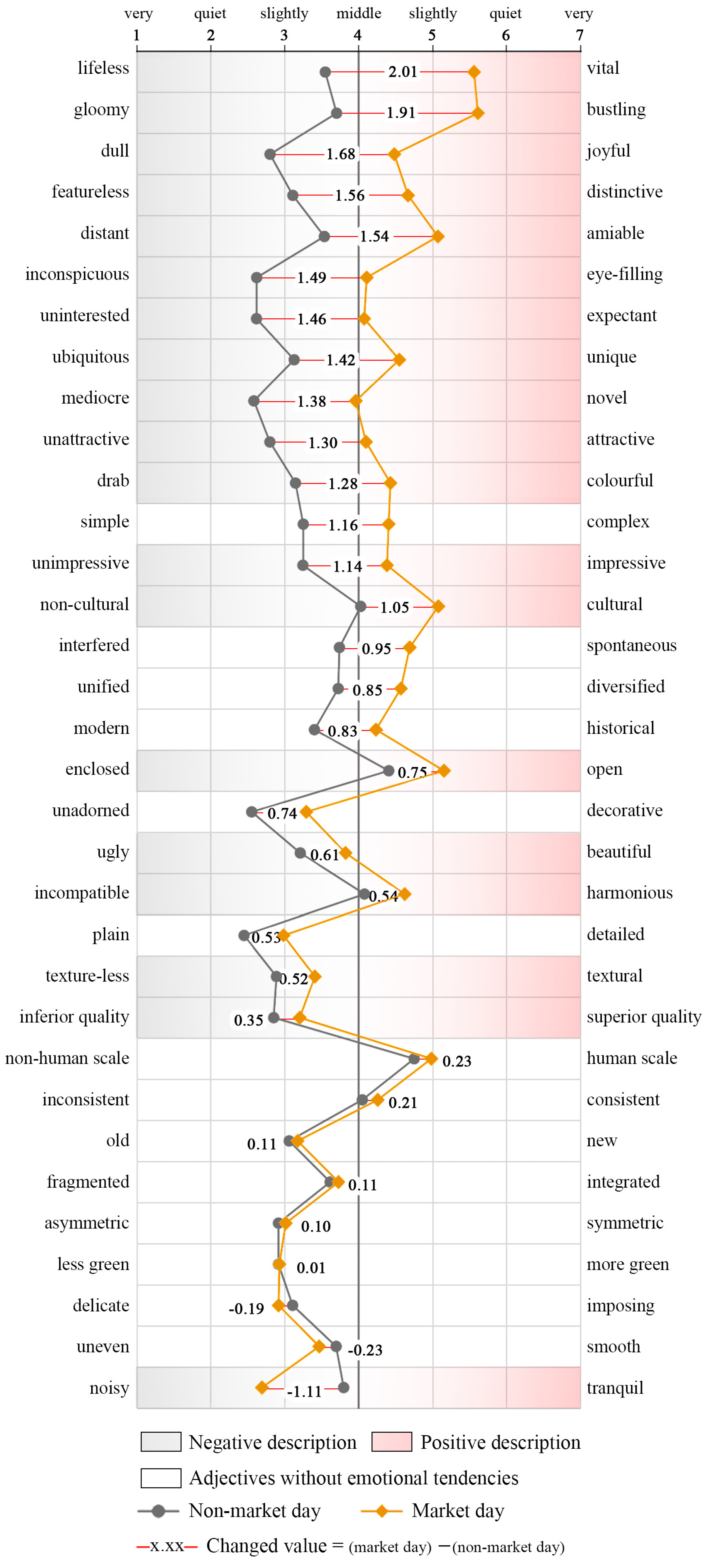



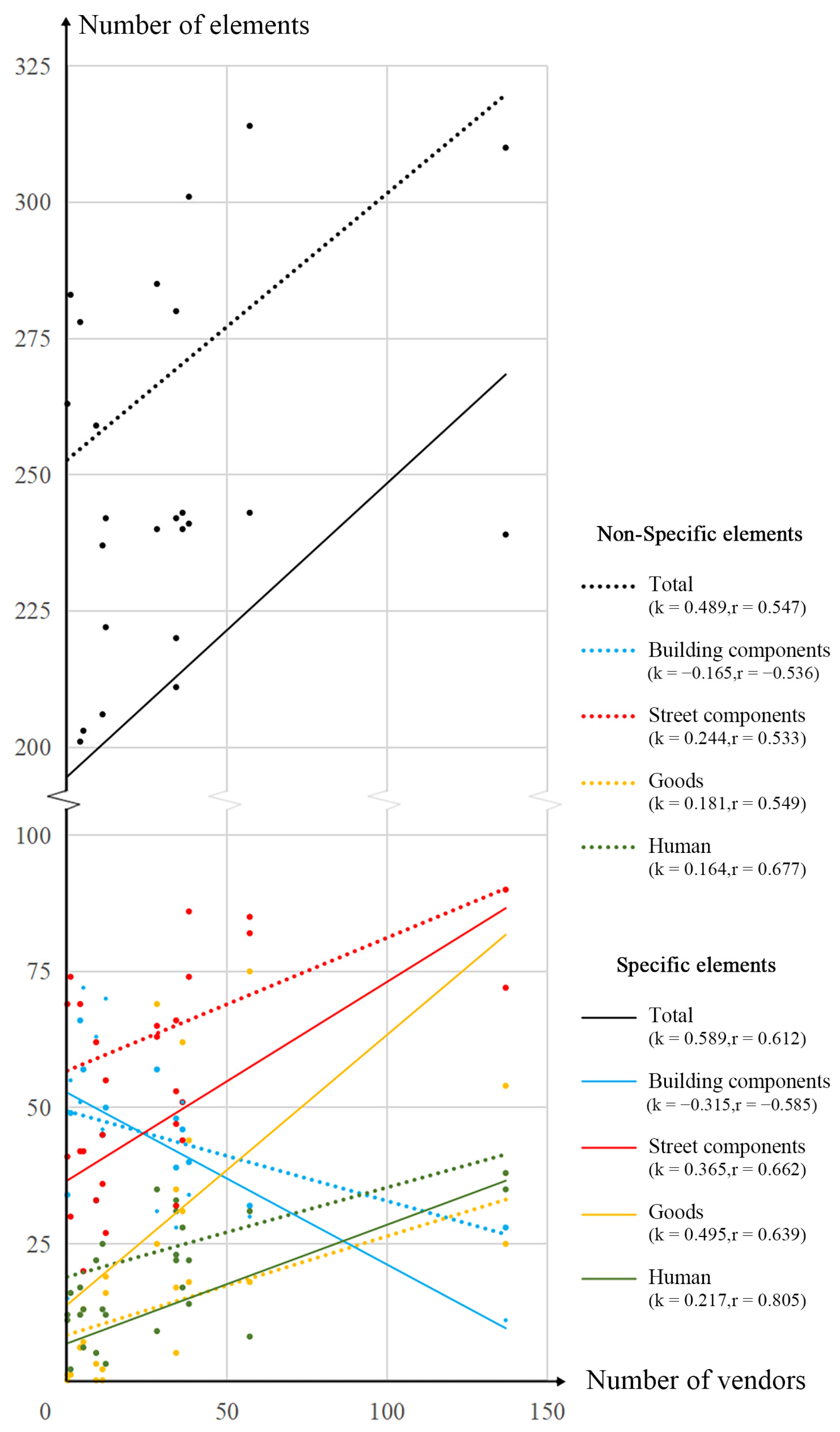
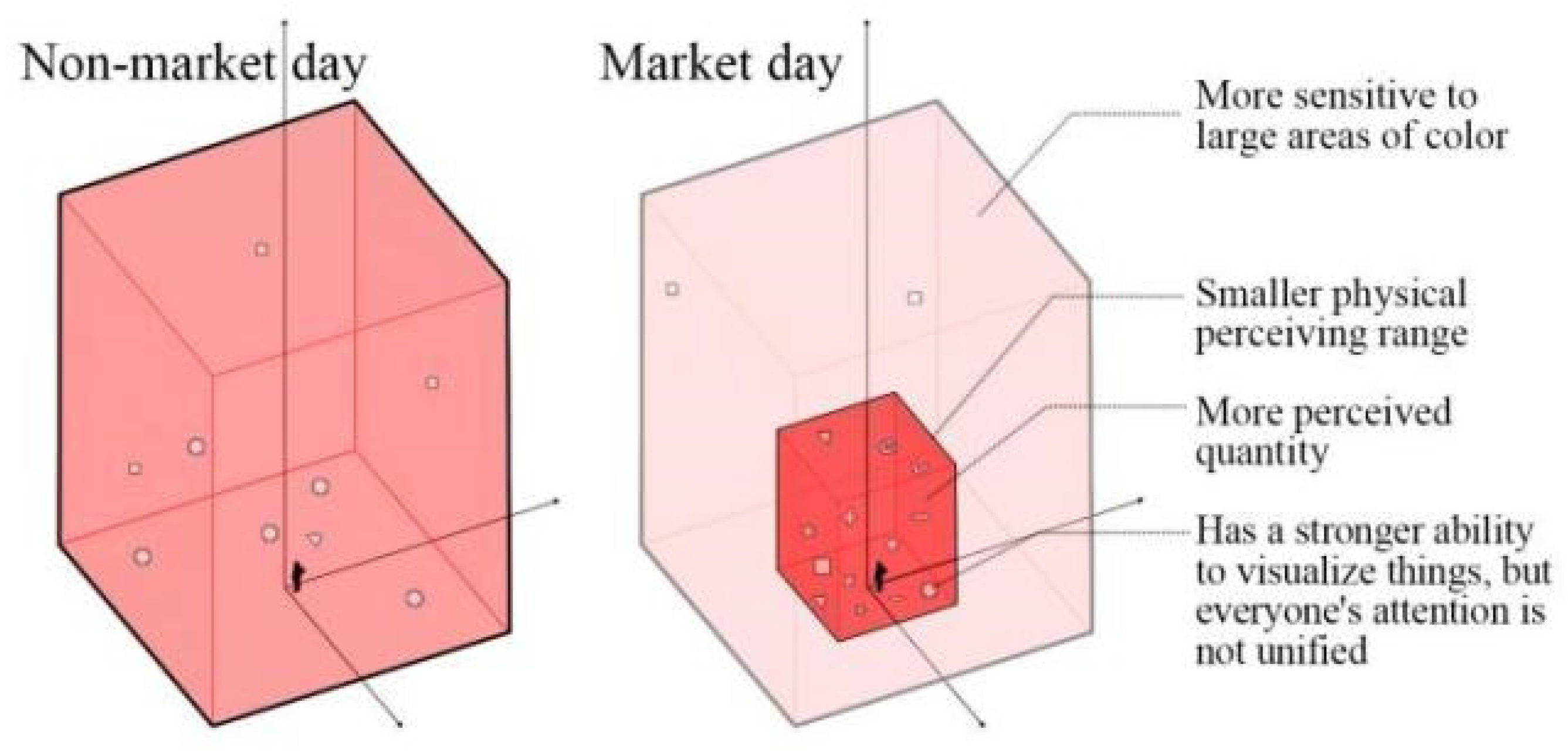
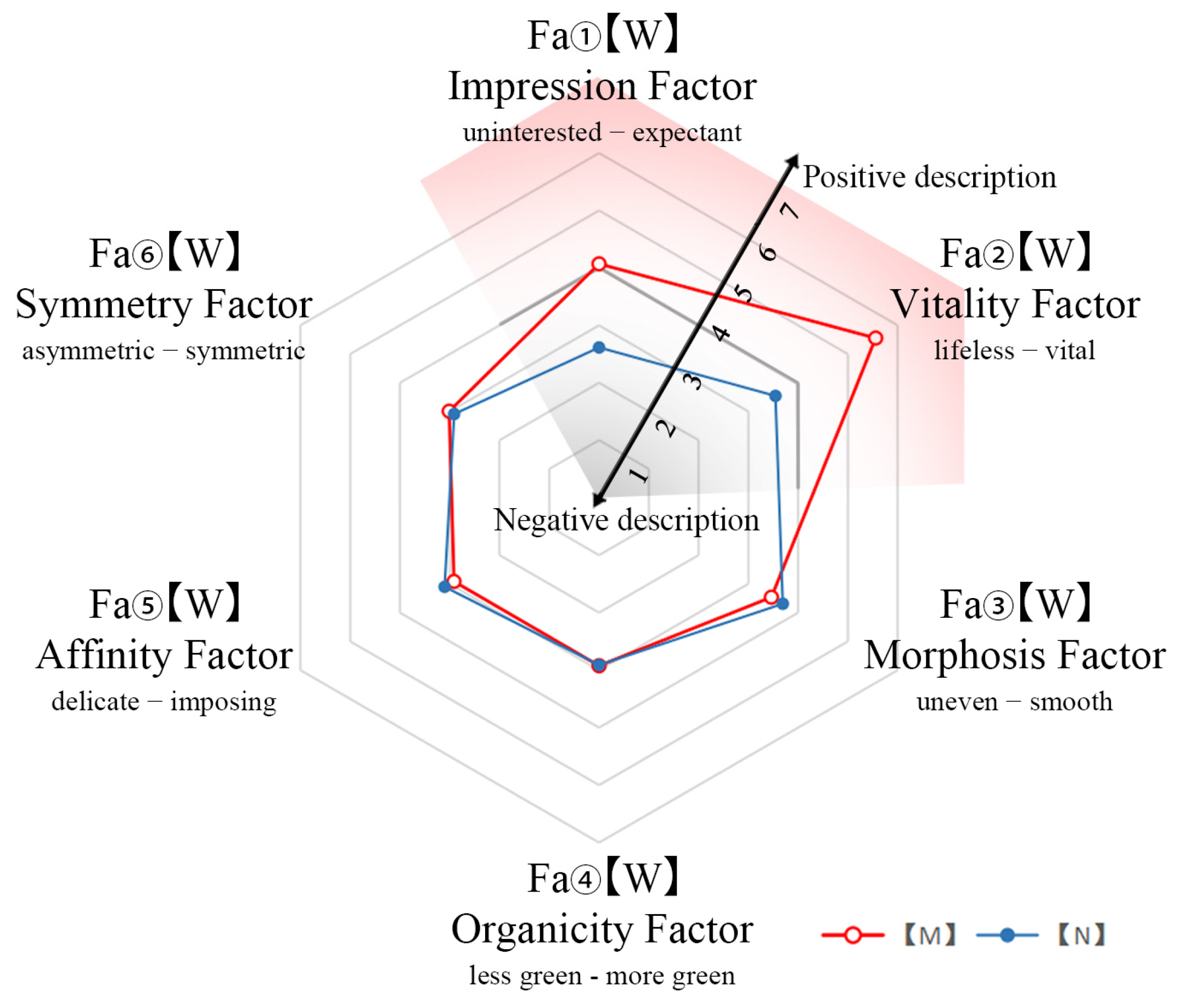

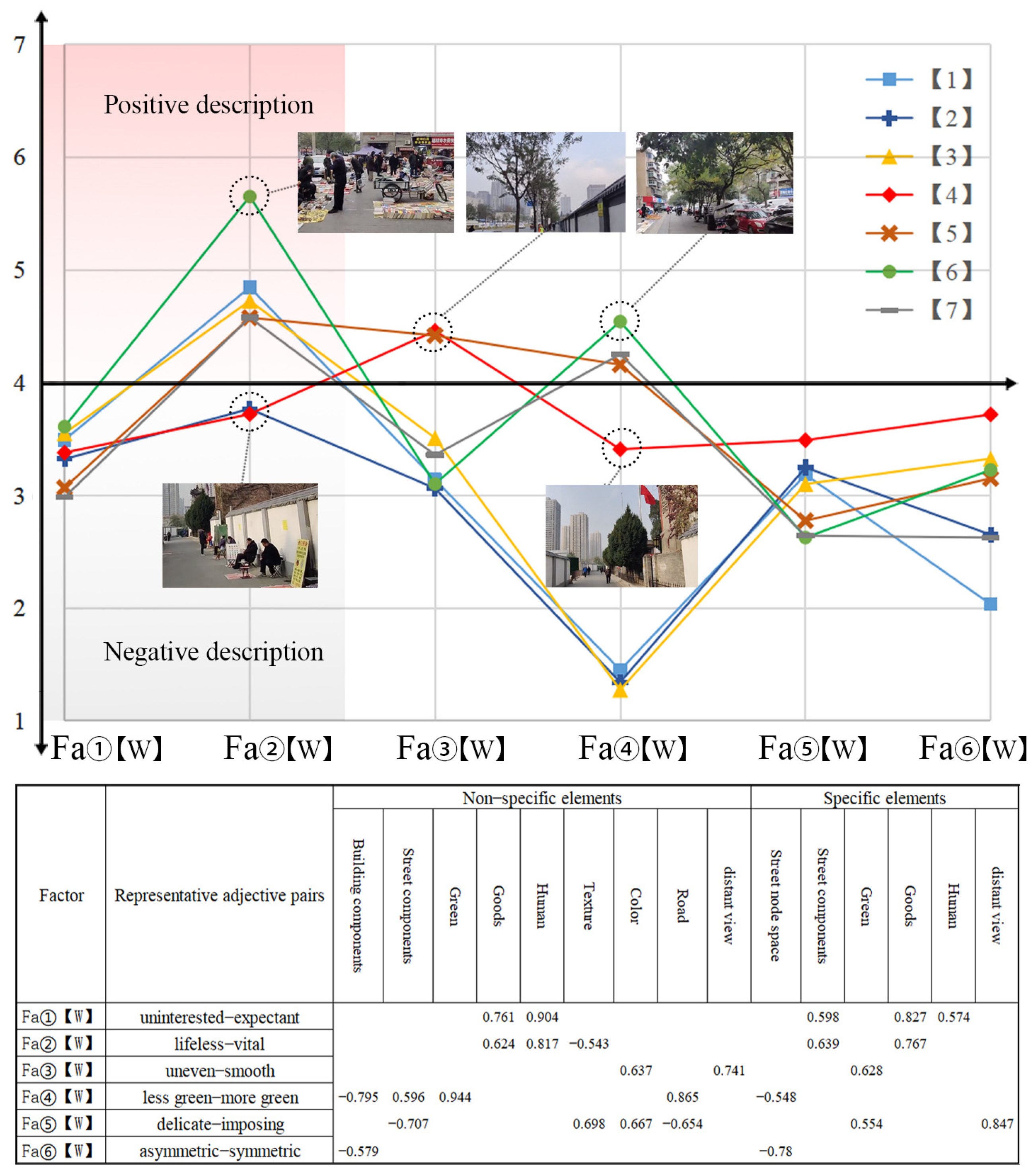
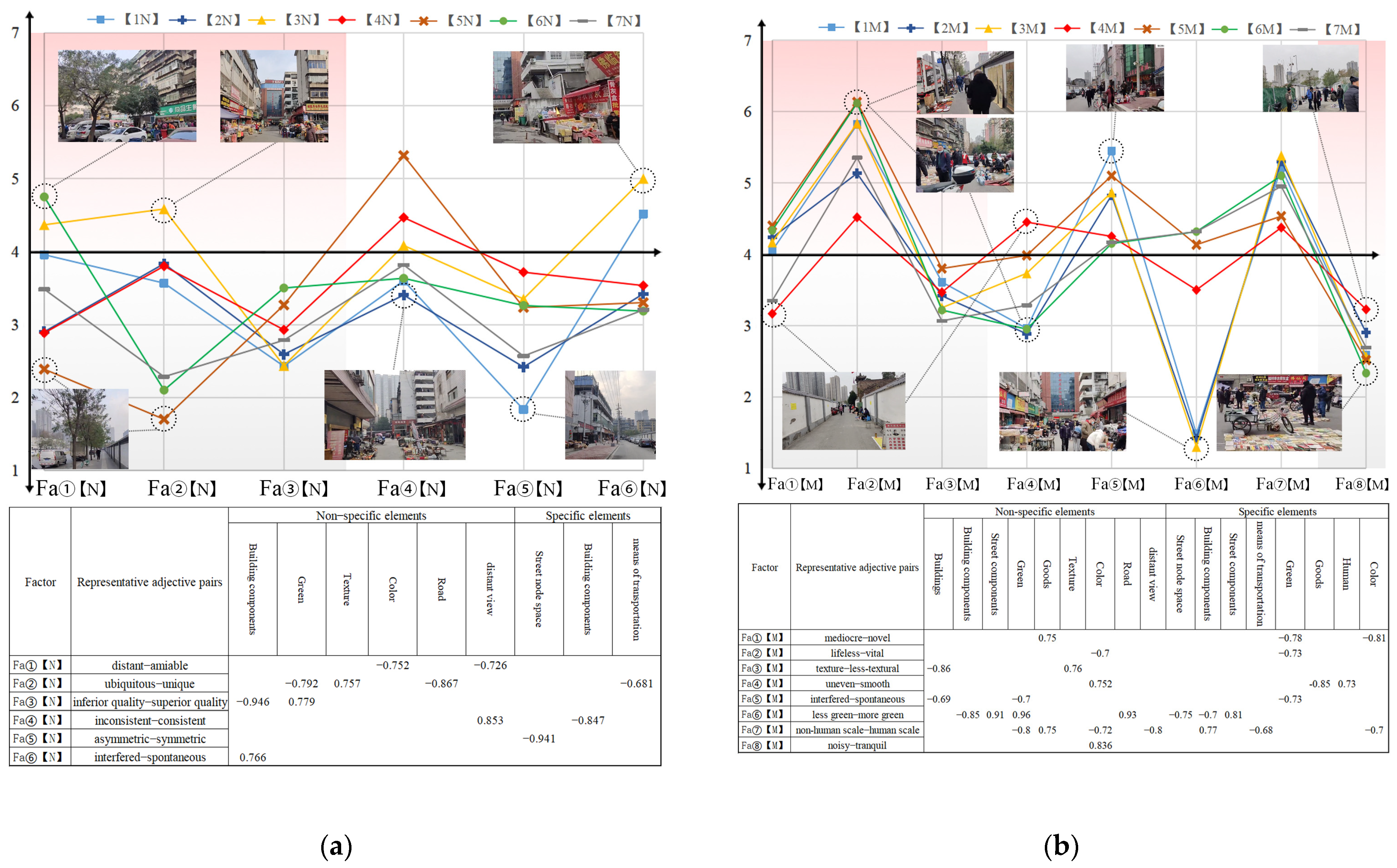
| Location | Research Streets | Street Number | Chinese Name / English Name | Length | Market Day / Non-Market Day Number | Number of Vendors |
|---|---|---|---|---|---|---|
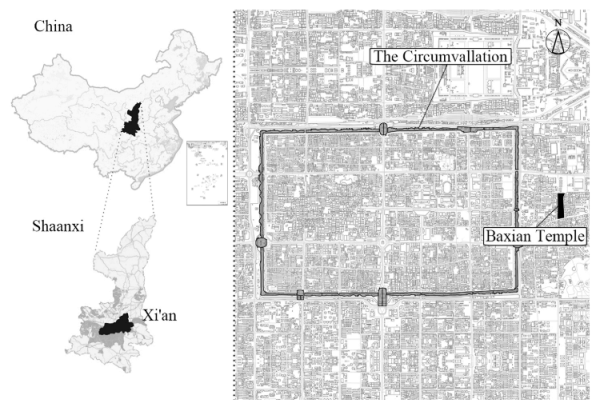 | 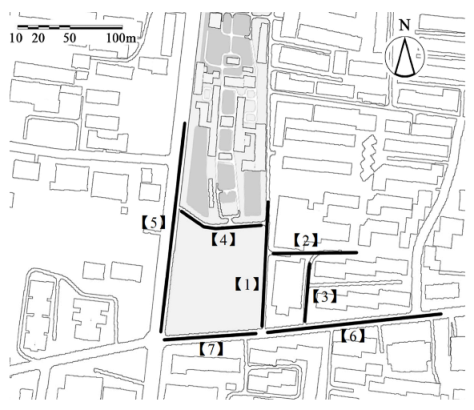 | 【1】 | 北火巷南段路 South section of Beihuo Alley | 112 m | 【1N】 | 4 |
| 【1M】 | 28 | |||||
| 【2】 | 古玩城东西路 East and West Section of Antique City Road | 79 m | 【2N】 | 12 | ||
| 【2M】 | 36 | |||||
| 【3】 | 古玩城南北路 North and South Section Road of Antique City | 71 m | 【3N】 | 5 | ||
| 【3M】 | 34 | |||||
| 【4】 | 五道什字东街 East Wudao Shizi Street | 82 m | 【4N】 | 11 | ||
| 【4M】 | 34 | |||||
| 【5】 | 新乐路南段 South section of Xinle Road | 216 m | 【5N】 | 0 | ||
| 【5M】 | 137 | |||||
| 【6】 | 长乐坊路东段 East section of Changle Alley | 221 m | 【6N】 | 9 | ||
| 【6M】 | 57 | |||||
| 【7】 | 长乐坊路西段 East section of Changle Alley | 95 m | 【7N】 | 1 | ||
| 【7N】 | 38 |
| Baxian Temple Street Space Whole—Factor Loading Diagram | ||||||||
|---|---|---|---|---|---|---|---|---|
| Kaiser–Meyer–Olkin Measure of Sampling Adequacy. | 0.927 | Factor | ||||||
| Bartlett’s Test of Sphericity | Approx. Chi–Square | 9273.871 | 1 | 2 | 3 | 4 | 5 | 6 |
| df | 528 | |||||||
| Sig. | 0.000 | |||||||
| Fa① Impression Factor | uninterested–expectant | 0.818 | 0.226 | 0.03 | 0.014 | −0.01 | −0.021 | |
| featureless–distinctive | 0.814 | 0.197 | 0.094 | −0.173 | −0.108 | −0.03 | ||
| mediocre–novel | 0.803 | 0.231 | −0.059 | 0.053 | 0.055 | 0.094 | ||
| unimpressive–impressive | 0.799 | −0.024 | 0.092 | −0.215 | −0.024 | 0.026 | ||
| unattractive–attractive | 0.784 | 0.239 | 0.072 | 0.021 | 0.176 | 0.103 | ||
| ubiquitous–unique | 0.773 | 0.006 | −0.022 | −0.341 | −0.152 | −0.022 | ||
| inconspicous–eye-filling | 0.727 | 0.389 | −0.139 | 0.093 | 0.13 | 0.165 | ||
| dull–joyful | 0.682 | 0.464 | −0.094 | 0.067 | 0.261 | 0.136 | ||
| unadorned–decorative | 0.643 | −0.014 | 0.018 | 0.104 | 0.463 | 0.051 | ||
| simple–complex | 0.617 | 0.3 | −0.323 | −0.016 | 0.205 | 0.106 | ||
| texture–less-textural | 0.614 | 0.011 | 0.213 | 0.11 | −0.069 | −0.19 | ||
| ugly–beautiful | 0.613 | 0.114 | 0.302 | 0.269 | 0.026 | −0.172 | ||
| plain–detailed | 0.605 | 0.084 | 0.034 | 0.274 | 0.349 | 0.106 | ||
| drab–colourful | 0.588 | 0.311 | −0.116 | −0.061 | 0.365 | 0 | ||
| inferior quality–superior quality | 0.563 | 0.101 | 0.132 | 0.52 | −0.17 | −0.154 | ||
| modern–historical | 0.53 | −0.024 | 0.096 | −0.498 | −0.234 | 0.042 | ||
| non-cultural–cultural | 0.49 | 0.365 | 0.105 | −0.452 | −0.132 | −0.032 | ||
| unified–diversified | 0.422 | 0.333 | −0.389 | 0.041 | 0.164 | −0.188 | ||
| Fa② Vitality Factor | lifeless–vital | 0.445 | 0.697 | −0.006 | 0.076 | 0.145 | −0.008 | |
| gloomy–bustling | 0.477 | 0.675 | 0.001 | −0.082 | 0.244 | −0.064 | ||
| enclosed–open | −0.028 | 0.654 | 0.202 | 0.252 | 0.031 | −0.173 | ||
| distant–amiable | 0.475 | 0.588 | 0.008 | −0.065 | 0.342 | 0.004 | ||
| noisy–tranquil | −0.038 | −0.563 | 0.222 | −0.039 | −0.046 | −0.272 | ||
| Fa③ Morphosis Factor | uneven–smooth | −0.033 | −0.098 | 0.731 | 0.216 | −0.031 | −0.011 | |
| inconsistent–consistent | −0.031 | 0.082 | 0.72 | −0.081 | 0.024 | 0.289 | ||
| fragmented–integrated | 0.125 | −0.027 | 0.692 | 0.061 | −0.008 | 0.007 | ||
| incompatible–harmonious | 0.398 | 0.376 | 0.466 | 0.153 | 0.225 | −0.135 | ||
| Fa④ Organicity Factor | less green–more green | 0.067 | 0.176 | 0.043 | 0.726 | −0.142 | 0.206 | |
| old–new | 0.106 | 0.176 | 0.244 | 0.701 | 0.128 | −0.007 | ||
| interfered–spontaneous | 0.231 | 0.374 | −0.041 | −0.507 | −0.092 | 0.115 | ||
| Fa⑤ Affinity Factor | delicate–imposing | 0.149 | −0.227 | 0.1 | −0.077 | −0.638 | −0.151 | |
| non-human scale–human scale | 0.273 | 0.156 | 0.231 | −0.063 | 0.571 | −0.348 | ||
| Fa⑥ Symmetry Factor | Asymmetric–symmetric | 0.132 | 0.024 | 0.311 | 0.065 | 0.05 | 0.762 | |
| Total | 9.11 | 3.499 | 2.564 | 2.559 | 1.834 | 1.21 | ||
| % of variance | 27.605 | 10.602 | 7.769 | 7.755 | 5.558 | 3.668 | ||
| Cumulative % | 27.605 | 38.207 | 45.976 | 53.73 | 59.288 | 62.956 | ||
| Street Number | Number of Vendors | Non-Specific Elements | Specific Elements | |||||||||||||||||||||||
|---|---|---|---|---|---|---|---|---|---|---|---|---|---|---|---|---|---|---|---|---|---|---|---|---|---|---|
| Total | Buildings | Building Components | Street Components | Means of Transportation | Green | Goods | Human | Texture | Color | Road | Distant View | Total | Buildings | Street Node Space | Building Components | Street Components | Means of Transportation | Green | Goods | Human | Texture | Color | Road | Distant View | ||
| 1M | 28 | 285 | 10 | 57 | 65 | 48 | 7 | 25 | 35 | 6 | 13 | 14 | 5 | 240 | 11 | 12 | 31 | 63 | 12 | 2 | 69 | 9 | 7 | 21 | 2 | 1 |
| 2M | 36 | 240 | 18 | 46 | 51 | 31 | 2 | 31 | 28 | 3 | 16 | 6 | 8 | 243 | 15 | 13 | 51 | 44 | 2 | 4 | 62 | 17 | 10 | 22 | 2 | 1 |
| 3M | 34 | 242 | 21 | 48 | 47 | 30 | 4 | 32 | 33 | 4 | 11 | 9 | 3 | 211 | 28 | 5 | 53 | 32 | 10 | 5 | 35 | 22 | 2 | 14 | 2 | 3 |
| 4M | 34 | 280 | 15 | 39 | 66 | 36 | 29 | 5 | 31 | 5 | 28 | 16 | 10 | 220 | 18 | 6 | 28 | 53 | 13 | 13 | 17 | 23 | 7 | 39 | 0 | 3 |
| 5M | 137 | 310 | 7 | 28 | 90 | 41 | 24 | 25 | 35 | 5 | 19 | 24 | 12 | 239 | 4 | 4 | 11 | 72 | 18 | 4 | 54 | 38 | 2 | 28 | 4 | 0 |
| 6M | 57 | 314 | 27 | 32 | 82 | 58 | 27 | 18 | 31 | 4 | 4 | 25 | 6 | 243 | 14 | 2 | 30 | 85 | 10 | 6 | 75 | 8 | 4 | 9 | 0 | 0 |
| 7M | 38 | 301 | 19 | 40 | 86 | 45 | 27 | 18 | 22 | 2 | 11 | 23 | 8 | 241 | 5 | 5 | 34 | 74 | 12 | 7 | 44 | 14 | 4 | 38 | 3 | 1 |
| 1N | 4 | 278 | 8 | 66 | 69 | 46 | 13 | 6 | 17 | 4 | 22 | 18 | 9 | 201 | 11 | 17 | 51 | 42 | 15 | 4 | 6 | 12 | 4 | 28 | 6 | 5 |
| 2N | 12 | 242 | 24 | 50 | 55 | 42 | 2 | 16 | 12 | 9 | 20 | 5 | 7 | 222 | 34 | 11 | 70 | 27 | 5 | 6 | 19 | 3 | 15 | 29 | 1 | 2 |
| 3N | 5 | 203 | 27 | 57 | 42 | 20 | 0 | 13 | 13 | 7 | 8 | 11 | 5 | 181 | 38 | 7 | 72 | 20 | 1 | 0 | 7 | 6 | 7 | 19 | 2 | 2 |
| 4N | 11 | 237 | 12 | 45 | 36 | 29 | 28 | 0 | 25 | 9 | 28 | 14 | 11 | 206 | 28 | 2 | 46 | 45 | 2 | 26 | 2 | 13 | 8 | 28 | 0 | 6 |
| 5N | 0 | 263 | 8 | 34 | 69 | 44 | 28 | 0 | 12 | 4 | 19 | 26 | 19 | 145 | 8 | 5 | 15 | 41 | 27 | 8 | 1 | 11 | 1 | 19 | 8 | 1 |
| 6N | 9 | 259 | 34 | 33 | 62 | 41 | 30 | 0 | 22 | 2 | 5 | 23 | 7 | 169 | 33 | 9 | 63 | 33 | 7 | 3 | 3 | 5 | 7 | 2 | 3 | 1 |
| 7N | 1 | 283 | 24 | 49 | 74 | 40 | 29 | 1 | 16 | 3 | 16 | 22 | 9 | 182 | 10 | 10 | 55 | 30 | 9 | 5 | 1 | 2 | 8 | 48 | 3 | 1 |
Disclaimer/Publisher’s Note: The statements, opinions and data contained in all publications are solely those of the individual author(s) and contributor(s) and not of MDPI and/or the editor(s). MDPI and/or the editor(s) disclaim responsibility for any injury to people or property resulting from any ideas, methods, instructions or products referred to in the content. |
© 2024 by the authors. Licensee MDPI, Basel, Switzerland. This article is an open access article distributed under the terms and conditions of the Creative Commons Attribution (CC BY) license (https://creativecommons.org/licenses/by/4.0/).
Share and Cite
Qi, Y.; Yue, L.; Guo, T.; Zhou, D.; Ren, Y.; Wang, M.; Liu, Y.; Yang, Y. A Study on the Perception of Local Characteristics in Cultural Street Vending Spaces, Taking Xi’an Baxian Temple as an Example. Buildings 2024, 14, 192. https://doi.org/10.3390/buildings14010192
Qi Y, Yue L, Guo T, Zhou D, Ren Y, Wang M, Liu Y, Yang Y. A Study on the Perception of Local Characteristics in Cultural Street Vending Spaces, Taking Xi’an Baxian Temple as an Example. Buildings. 2024; 14(1):192. https://doi.org/10.3390/buildings14010192
Chicago/Turabian StyleQi, Yingtao, Liping Yue, Tie Guo, Dian Zhou, Yulin Ren, Mengying Wang, Yujia Liu, and Yujun Yang. 2024. "A Study on the Perception of Local Characteristics in Cultural Street Vending Spaces, Taking Xi’an Baxian Temple as an Example" Buildings 14, no. 1: 192. https://doi.org/10.3390/buildings14010192
APA StyleQi, Y., Yue, L., Guo, T., Zhou, D., Ren, Y., Wang, M., Liu, Y., & Yang, Y. (2024). A Study on the Perception of Local Characteristics in Cultural Street Vending Spaces, Taking Xi’an Baxian Temple as an Example. Buildings, 14(1), 192. https://doi.org/10.3390/buildings14010192







